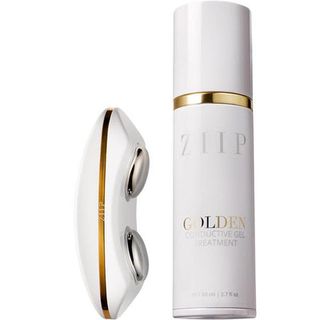I Tried a £425 Facial Device for a Month—These Are the Results

Facial devices have been big news for a while now, but one device that I see doing the rounds on Instagram is the Ziip nanocurrent device. Founded by Melanie Simons (Jennifer Aniston's go-to facialist), this handheld device uses electrical current to bring multiple benefits to the skin.
The device is often out of stock and has rave reviews. But I'll put my hands up—when I first received this device, I tried it a couple of times before it retired to my bedside table drawer for some time. I have never used it consistently or given it a proper chance, so I decided it was time to dust it off and give it a month-long test drive to see if it can really give me a sculpted face and clear skin.
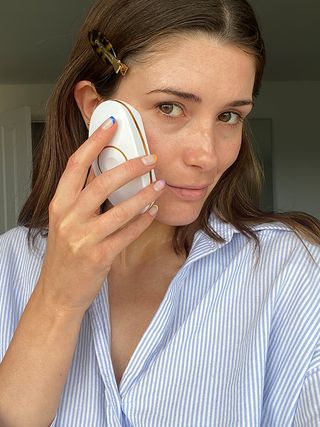
The Ziip device uses microcurrent and nanocurrent technology to lift, tone and clear the skin.
The device looks like a small computer mouse and features two metal probes that conduct the electrical currents. It also comes with a conductive gel, which is applied before the treatment to guide the current into the skin and is packed with ingredients to leave the skin hydrated and plumped.
How Does the Ziip Device Work?
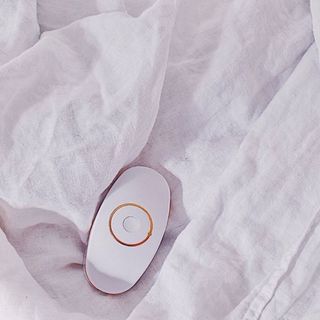
The Ziip uses electrical microcurrent and nanocurrent, which provide different benefits to the skin. It primarily uses nanocurrent as its main wavelengths to treat the skin.
"Nanocurrent is used to reestablish a tight appearance on our faces by stimulating the production of collagen formation through an electric current," explains Lisa Franklin, founder of Lisa Franklin Clinic Privé. "It accomplishes this by safely reacting with important skin cells and tissues to generate kinetic heat, which encourages the skin to organically generate new collagen fibres and more of the skin's natural plumping and moisturising ingredient, hyaluronic acid."
Nanocurrent also boosts the creation of ATP [aka adenosine triphosphate, which is slightly less catchy], which, as we become older, drops, explains Franklin. "This enables your cells to interact and repair themselves while also replenishing their stored energy. This results in skin that is healthy-looking, elevated and radiant."
Microcurrent, however, works in a slightly different way, explains Franklin, who offers this treatment via a computer-aided cosmetology instrument, or CACI, in her clinic. "Microcurrent focuses on exercising the muscle tone beneath the skin, enabling [the muscles] to strengthen while also improving cellular metabolism. Microcurrent treatments are more commonly used as a preventative step for people who want to slow down the natural look of ageing on their skin."
There are benefits of using both types of currents, says Franklin. "While NuFace and Ziip are similar, microcurrents and nanocurrents are different enough that they complement each other well and can be used together," she says.
How to Prepare for a Ziip Treatment
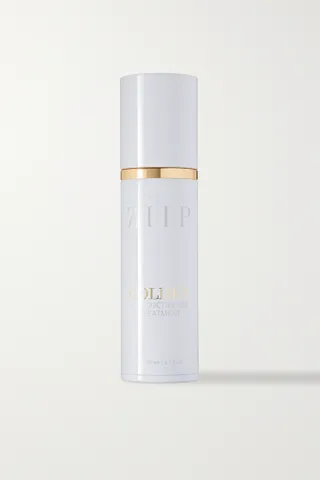
The conductive gel is packed with active ingredients to boost the complexion as well as guide the electrical current through the skin.
To begin your treatment, you apply the conductive gel all over your face and neck. This helps the currents to deliver the effects to your skin while plumping and hydrating the skin, too. It can also be left on once you've finished your treatment. However, I found it to be quite sticky, so I chose to wash this off my face if I was planning to wear makeup and instead choosing to leave it on overnight if I was using the device before bed.
What to Expect From a Ziip Treatment
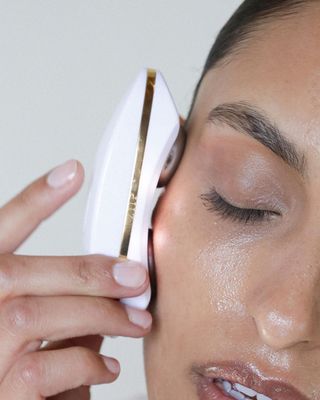
What makes the Ziip device so great is the accompanying app that you can download onto your phone. The app features lots of different treatments to target different areas of your face, so you can tailor your treatment to the specific areas or concerns you want to address on any given day. You can sync these treatments to your device via Bluetooth, and you can watch Melanie Simons conduct the treatment via a video tutorial as you follow along. These treatments are also updated regularly, so regardless of when you buy your device, you'll have access to the latest treatments on the app.
The treatments currently range from Energise (an all-over treatment to give the skin a glow, soften fine lines and tighten the skin) to more targeted treatments, such as 11s, which help to treat frown lines between the eyes and forehead. There are also treatments to target blemishes and pigmentation and lifting and sculpting treatments designed to depuff the skin and lift the jawline and brows. Treatments last between two and 12 minutes, so they can easily be slotted into your day. You can also "stack" different treatments by conducting them one after the other if you have a special event or want to give yourself an all-bases-covered type of treatment.
Depending on the treatment, you might experience some tingling or involuntary twitching as you pass the device over your skin. I could feel some tingling during the Total Smoothing treatment, which is designed to target breakouts. As I moved over areas of breakouts on my chin and jaw, I could feel a tingling sensation on these areas as the current passed through my skin. Equally, with the Energise treatment, my lips would occasionally quiver as I moved the Ziip around my mouth, and I could feel a tingling sensation in my teeth. This was totally painless (and Simons explains that this is totally normal to experience), but it does feel odd at first.
Ziip Device: Before and After Treatment
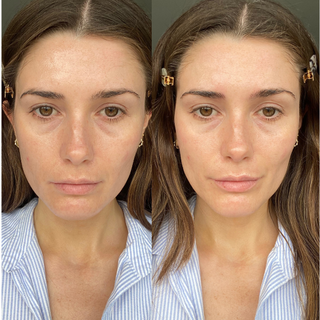
Before and immediately after using the Ziip Energise treatment.
Is the Ziip Device Worth It?

My skin after using the Ziip device for one month.
In my honest opinion, I think the Ziip device is worth it. But I think this depends on what you want from the device and how high your expectations are. For example, I found the Total Smoothing treatment worked wonders at taking down blemishes and pigmentation, and I liked that I could actually feel it working on areas that are breakout-prone.
However, while the lifting and sculpting treatments like the Energise treatment did make my complexion look more awake, did it give me a snatched brow and jawline? Not exactly. My eyes looked more open and awake, and my cheekbones looked slightly more defined, but I didn't end my treatment looking like Bella Hadid. However, the appearance of my skin really did improve. My complexion looked brighter and even, and on the evenings when I left the conductive gel on overnight, I found that I woke up with really hydrated, calm and glowy skin the next day. I also noticed a softening of the lines on my forehead. I loved the instant results from using this, and I could see my skin improving after a couple of weeks' use.
I think this is worth the investment if you plan on using it every day. Much like going to the gym (and getting the most out of your membership fee), you only get stronger with regular practice, and the same goes for facial devices. If you commit to using this regularly, the cost per use is minimal, and you'll see results. However, if you find that you buy into skincare devices and they end up gathering dust in your drawer, then you might be better off investing in a course of microcurrent/nanocurrent treatments in a clinic. It's also worth bearing in mind that you'll need to purchase conductive gel top-ups, which start at £45 for the Silver Conductive Gel and go up to £110 for the Golden Conductive Gel.
At-Home vs. In-Clinic Nanocurrent and Microcurrent Treatments
So how do at-home microcurrent and nanocurrent devices compare to in-clinic treatments? "The currents used in the professional machines in-clinic have a stronger depth [that] a specialist can manage the safe performance of, working on each muscle for even distribution," says Franklin. "We work on a treatment programme with our CACI machines, which safely works the muscles and increases the current over the course of several weeks. This provides longer-term results by building and strengthening the muscles gradually and correctly." While a course of treatment is best to achieve optimum results, you can also get great results from one treatment. "If you have a special event or wedding, a one-off treatment can give you an immediate glow, and results can last for a few days," adds Franklin. The cost of a treatment will vary depending on your location, but in London, you can expect to pay around the £100 to £140 mark for a single microcurrent treatment. So depending on your needs, you might find the Ziip an investment that works out to be a better value in the long run.
Up next, I Asked Beauty Editors Which Skincare Brands Are Really Worth the Money

Eleanor Vousden is the beauty editor for Who What Wear UK. She was previously deputy editor at Hairdressers Journal, health writer at Woman & Home and junior beauty editor at beauty website Powder. She has also contributed to Wallpaper and Elle Collections with written and styling work.
Working as a beauty journalist since 2015 after graduating in fashion journalism at the London College of Fashion, she has been highly commended at the BSME Talent Awards for her work on Powder and also contributed to the title winning Website of the Year at the PPA Awards.
Eleanor’s journalistic focus is to provide readers with honest and helpful beauty content. Through words, video and live broadcast, she has interviewed several celebrity makeup artists, hairstylists and top dermatologists throughout her career, as well as celebrities such as Sarah Jessica Parker and Scarlett Johansson. She has a particular interest in finding solutions for acne and eczema, which she has experienced firsthand. She has also amassed a large collection of fragrances and can never say no to a new candle.
When she’s not writing or testing the latest beauty product or treatments, she’s on the seafront in her hometown of Brighton and Hove, where she lives with her partner and her miniature dachshund.
-
 Hunter Schafer Wore 2024's Most Viral Shoes to the Challengers After-Party
Hunter Schafer Wore 2024's Most Viral Shoes to the Challengers After-PartyStop making such tempting shoes, Miuccia. Please.
By Eliza Huber
-
 Anya Taylor-Joy Just Wore The Controversial Flat Shoe That Always Divides Our Editors
Anya Taylor-Joy Just Wore The Controversial Flat Shoe That Always Divides Our EditorsLove them or hate them.
By Natalie Munro
-
 J.Lo Wore the Chic Heel Color Everyone Will Wear Instead of Black This Summer
J.Lo Wore the Chic Heel Color Everyone Will Wear Instead of Black This SummerIt makes every outfit look pricey.
By Allyson Payer
